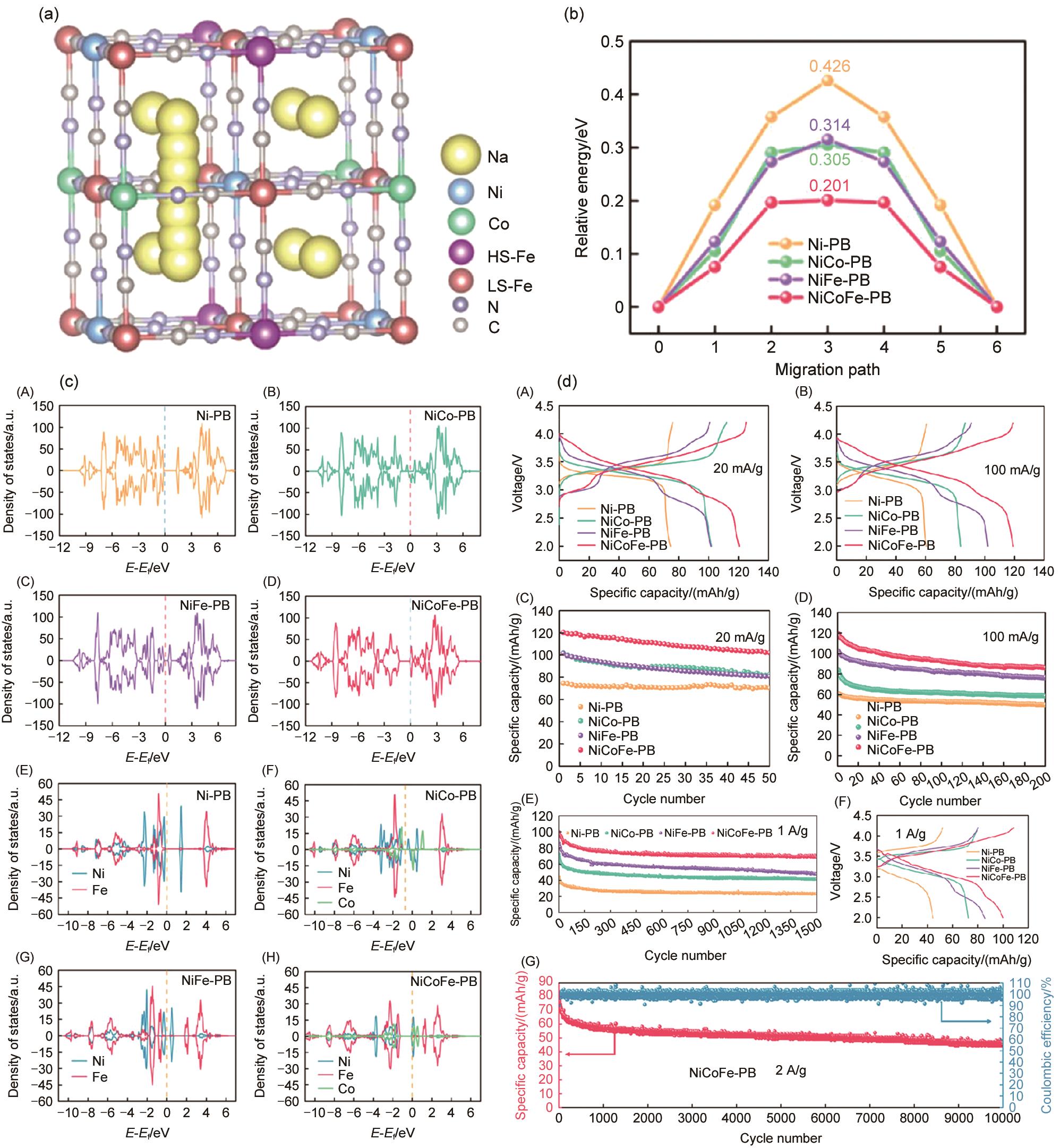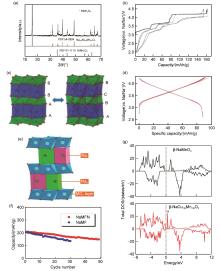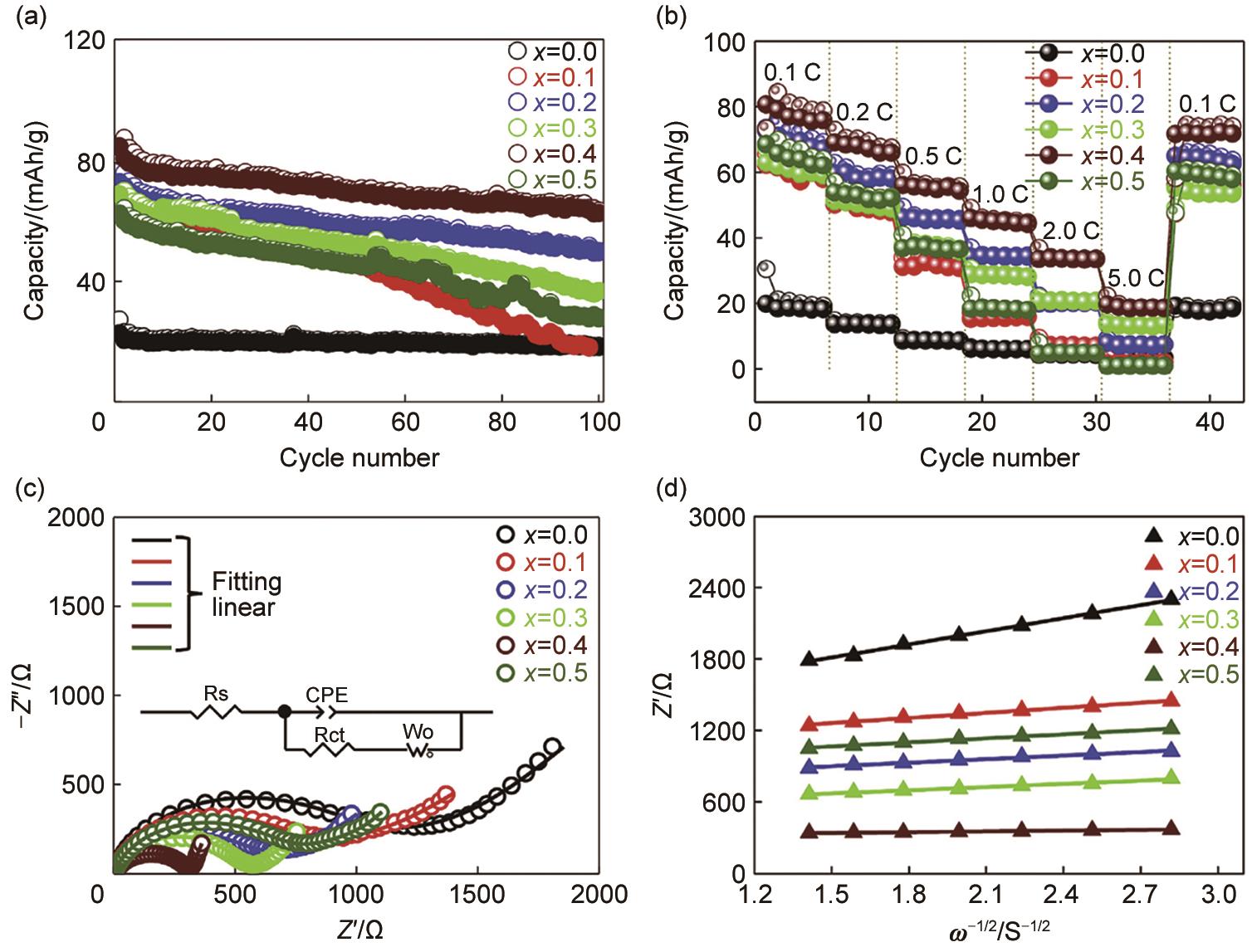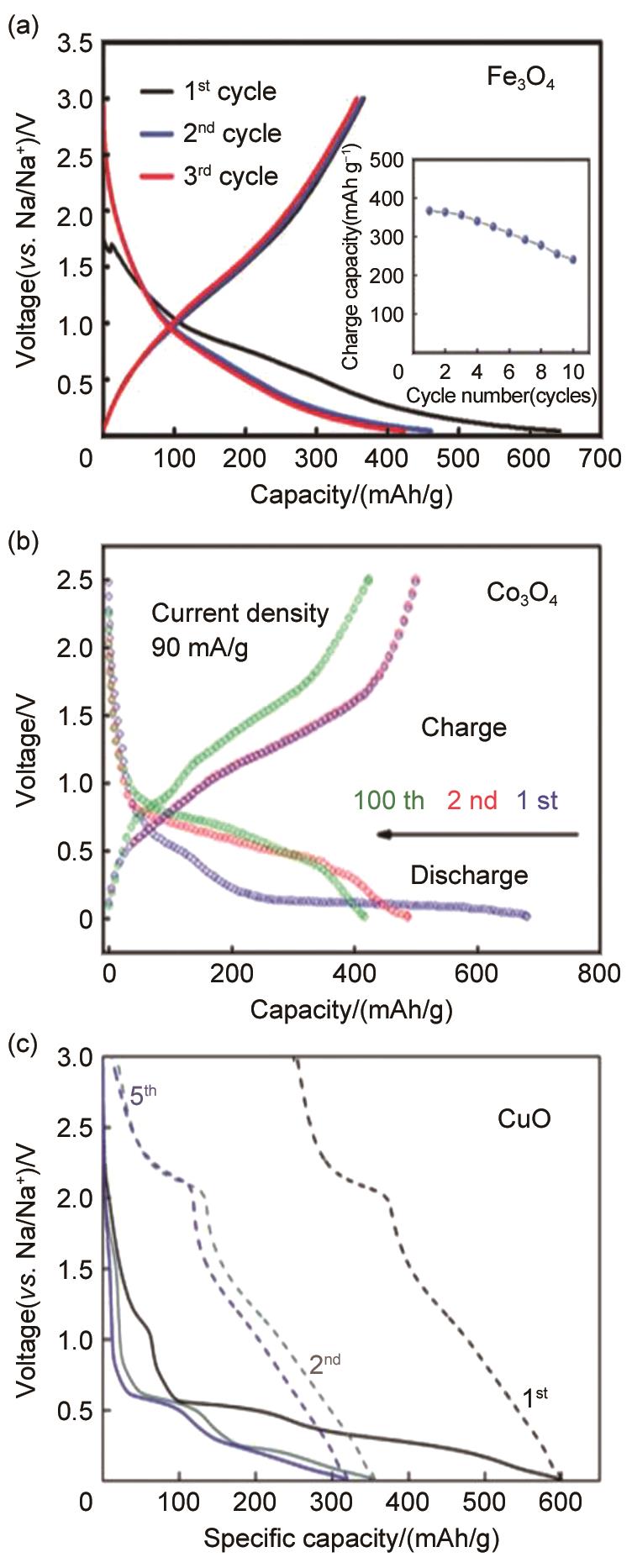Energy Storage Science and Technology ›› 2023, Vol. 12 ›› Issue (5): 1332-1347.doi: 10.19799/j.cnki.2095-4239.2023.0163
• Special Issue on Key Materials and Recycling Technologies for Energy Storage Batteries • Previous Articles Next Articles
Yuwen ZHAO1( ), Huan YANG1, Junpeng GUO1, Yi ZHANG1, Qi SUN2, Zhijia ZHANG1(
), Huan YANG1, Junpeng GUO1, Yi ZHANG1, Qi SUN2, Zhijia ZHANG1( )
)
Received:2023-03-21
Revised:2023-04-22
Online:2023-05-05
Published:2023-05-29
Contact:
Zhijia ZHANG
E-mail:18332926781@qq.com;zhangzhijia@tiangong.edu.cn
CLC Number:
Yuwen ZHAO, Huan YANG, Junpeng GUO, Yi ZHANG, Qi SUN, Zhijia ZHANG. Application of magnetic metal elements in sodium ion batteries[J]. Energy Storage Science and Technology, 2023, 12(5): 1332-1347.

Fig. 2
(a) The optimized migration paths of Na+ ions for NiCoFe-PB, and (b) the energy barrier profiles of four samples; (c) (A—D) The total density of state patterns, and (E—H) the partial density of state patterns of four Ni-PB species; (d) (A, B) The initial charge/discharge profiles at 20 mA/g and 100 mA/g of four samples, (C, D) corresponding cycle performance, and (E, F) long cycle performance and initial charge/discharge profiles at 1 A/g of four samples, (G) Long cycle performance of NiCoFe-PB at 2 A/g"


Fig. 4
(a) The XRD patterns of the P2-NaNM; (b) Voltage-specifific capacity profifile for the Na/P2-NaNM half-cell; (c) The structural schematics of the P2-O2 phase transition and stacking sequence of oxygen layers; (d) The charge/discharge profifiles of P2-Na2/3Ni1/3Mn1/3Ti1/3O2 at 0.1C in 2.5—4.15 V; (e) Diagrammatic presentation of the P2-type structures of the Na x MO2 phases; (f) Cycling performance of the NaMF and NaMFN cathodes at 0.05C; (g) Calculated total density of states (DOS) for β-NaMnO2 and β-NaCu1/8Mn7/8O2"


Fig. 6
(a) The electrochemical performance for Na3Mn2-x Fe x P3O11@C (0≤ x ≤0.5) samples: (a) cycling performance at 0.1 C over 100 cycles; (b) rate performance from 0.1 C to 5 C; (c) Nyquist plots before cycling in the frequency range from 0.01 Hz to 100 kHz (equivalent circuit inserted); (d) the relationship between Z ’ and ω-1/2 in the low-frequency range"


Fig. 10
(a) Charge/discharge profiles of Fe3O4 anodes in the voltage window 0.04—3.0 V vs Na+/Na (Inset: cycle stability); (b) Electrochemical charge/discharge profiles of Co3O4 anodes in the voltage range between 0.01 and 2.5 V vs Na+/Na; (c) Charge/discharge curves of CuO anodes in the voltage window 0.01—3.0 V vs Na+/Na"

| 1 | XIANG X D, ZHANG K, CHEN J. Recent advances and prospects of cathode materials for sodium-ion batteries[J]. Advanced Materials, 2015, 27(36): 5343-5364. |
| 2 | CHU S, CUI Y, LIU N. The path towards sustainable energy[J]. Nature Materials, 2017, 16(1): 16-22. |
| 3 | TARASCON J M. Key challenges in future Li-battery research[J]. Philosophical Transactions Series A, Mathematical, Physical, and Engineering Sciences, 2010, 368(1923): 3227-3241. |
| 4 | XIAO B W, ROJO T, LI X L. Hard carbon as sodium-ion battery anodes: Progress and challenges[J]. ChemSusChem, 2019, 12(1): 133-144. |
| 5 | PARANT J P, OLAZCUAGA R, DEVALETTE M, et al. Sur quelques nouvelles phases de formule NaxMnO2 (x≤1)[J]. Journal of Solid State Chemistry, 1971, 3(1): 1-11. |
| 6 | WHITTINGHAM M S. Chemistry of intercalation compounds: Metal guests in chalcogenide hosts[J]. Progress in Solid State Chemistry, 1978, 12(1): 41-99. |
| 7 | YOSHINO A. The birth of the lithium-ion battery[J]. Angewandte Chemie International Edition, 2012, 51(24): 5798-5800. |
| 8 | CAO Y L, XIAO L F, SUSHKO M L, et al. Sodium ion insertion in hollow carbon nanowires for battery applications[J]. Nano Letters, 2012, 12(7): 3783-3787. |
| 9 | CAO Y L, XIAO L F, WANG W, et al. Reversible sodium ion insertion in single crystalline manganese oxide nanowires with long cycle life[J]. Advanced Materials, 2011, 23(28): 3155-3160. |
| 10 | MUKHERJEE S, REN Z K, SINGH G. Beyond graphene anode materials for emerging metal ion batteries and supercapacitors[J]. Nano-Micro Letters, 2018, 10(4): 70. |
| 11 | WANG S W, WANG L J, ZHU Z Q, et al. All organic sodium-ion batteries with Na4C8H2O6[J]. Angewandte Chemie International Edition, 2014, 53(23): 5892-5896. |
| 12 | MUKHERJEE S, REN Z K, SINGH G. Molecular polymer-derived ceramics for applications in electrochemical energy storage devices[J]. Journal of Physics D: Applied Physics, 2018, 51(46): 463001. |
| 13 | 胡勇胜, 陆雅翔, 陈立泉. 钠离子电池科学与技术[M]. 北京: 科学出版社, 2020. |
| HU Y S, LU Y X, CHEN L Q. Na-ion batteries: Science and technology[M]. Beijing: Science Press, 2020. | |
| 14 | TANG X, LIU H, SU D W, et al. Hierarchical sodium-rich Prussian blue hollow nanospheres as high-performance cathode for sodium-ion batteries[J]. Nano Research, 2018, 11(8): 3979-3990. |
| 15 | LU Y H, WANG L, CHENG J G, et al. Prussian blue: A new framework of electrode materials for sodium batteries[J]. Chemical Communications, 2012, 48(52): 6544-6546. |
| 16 | QIAN J F, WU C, CAO Y L, et al. Prussian blue cathode materials for sodium-ion batteries and other ion batteries[J]. Advanced Energy Materials, 2018, 8(17): 1702619. |
| 17 | ORTIZ-VITORIANO N, DREWETT N E, GONZALO E, et al. High performance manganese-based layered oxide cathodes: Overcoming the challenges of sodium ion batteries[J]. Energy & Environmental Science, 2017, 10(5): 1051-1074. |
| 18 | NIE P, YUAN J R, WANG J, et al. Prussian blue analogue with fast kinetics through electronic coupling for sodium ion batteries[J]. ACS Applied Materials & Interfaces, 2017, 9(24): 20306-20312. |
| 19 | YANG D Z, XU J, LIAO X Z, et al. Prussian blue without coordinated water as a superior cathode for sodium-ion batteries[J]. Chemical Communications, 2015, 51(38): 8181-8184. |
| 20 | ZHANG L L, WEI C, FU X Y, et al. Ternary Ni-based Prussian blue analogue with superior sodium storage performance induced by synergistic effect of Co and Fe[J]. Carbon Energy, 2021, 3(5): 827-839. |
| 21 | WEI C, FU X Y, ZHANG L L, et al. Structural regulated nickel hexacyanoferrate with superior sodium storage performance by K-doping[J]. Chemical Engineering Journal, 2021, 421: 127760. |
| 22 | XU Z, SUN Y, XIE J, et al. High-performance Ni/Fe-codoped manganese hexacyanoferrate by scale-up synthesis for practical Na-ion batteries[J]. Materials Today Sustainability, 2022, 18: 100113. |
| 23 | TANG Y, LI W, FENG P Y, et al. High-performance Manganese hexacyanoferrate with cubic structure as superior cathode material for sodium-ion batteries[J]. Advanced Functional Materials, 2020, 30(10): 1908754. |
| 24 | MORITOMO Y, URASE S, SHIBATA T. Enhanced battery performance in manganese hexacyanoferrate by partial substitution[J]. Electrochimica Acta, 2016, 210: 963-969. |
| 25 | WANG L, SONG J, QIAO R M, et al. Rhombohedral Prussian white as cathode for rechargeable sodium-ion batteries[J]. Journal of the American Chemical Society, 2015, 137(7): 2548-2554. |
| 26 | HWANG J Y, MYUNG S T, SUN Y K. Sodium-ion batteries: Present and future[J]. Chemical Society Reviews, 2017, 46(12): 3529-3614. |
| 27 | KIM H, KIM H, DING Z, et al. Recent progress in electrode materials for sodium-ion batteries[J]. Advanced Energy Materials, 2016, 6(19): 1600943. |
| 28 | PALOMARES V, SERRAS P, VILLALUENGA I, et al. Na-ion batteries, recent advances and present challenges to become low cost energy storage systems[J]. Energy & Environmental Science, 2012, 5(3): 5884-5901. |
| 29 | YABUUCHI N, KUBOTA K, DAHBI M, et al. Research development on sodium-ion batteries[J]. Chemical Reviews, 2014, 114(23): 11636-11682. |
| 30 | BERTHELOT R, CARLIER D, DELMAS C. Electrochemical investigation of the P2-NaxCoO2 phase diagram[J]. Nature Materials, 2011, 10(1): 74-80. |
| 31 | WANG P F, YOU Y, YIN Y X, et al. Layered oxide cathodes for sodium-ion batteries: Phase transition, air stability, and performance[J]. Advanced Energy Materials, 2018, 8(8): 1701912. |
| 32 | CHEN T, LIU W F, ZHUO Y, et al. Single-phase P2-type layered oxide with Cu-substitution for sodium ion batteries[J]. Journal of Energy Chemistry, 2020, 43: 148-154. |
| 33 | WANG P F, YAO H R, LIU X Y, et al. Na+/vacancy disordering promises high-rate Na-ion batteries[J]. Science Advances, 2018, 4(3): eaar6018. |
| 34 | FANG Y J, YU X Y, LOU X W. A practical high-energy cathode for sodium-ion batteries based on uniform P2-Na0.7CoO2 microspheres[J]. Angewandte Chemie International Edition, 2017, 56(21): 5801-5805. |
| 35 | LIU Y C, SHEN Q Y, ZHAO X D, et al. Hierarchical engineering of porous P2-Na2/3Ni1/3Mn2/3O2 nanofibers assembled by nanoparticles enables superior sodium-ion storage cathodes[J]. Advanced Functional Materials, 2020, 30(6): 1907837. |
| 36 | ZARRABEITIA M, GOMES CHAGAS L, KUENZEL M, et al. Toward stable electrode/electrolyte interface of P2-layered oxide for rechargeable Na-ion batteries[J]. ACS Applied Materials & Interfaces, 2019, 11(32): 28885-28893. |
| 37 | PARK Y J, CHOI J U, JO J H, et al. A new strategy to build a high-performance P'2-type cathode material through titanium doping for sodium-ion batteries[J]. Advanced Functional Materials, 2019, 29(28): 1901912. |
| 38 | ZHOU D M, HUANG W X, ZHAO F L, et al. The effect of Na content on the electrochemical performance of the O3- type NaxFe0.5Mn0.5O2 for sodium-ion batteries[J]. Journal of Materials Science, 2019, 54(9): 7156-7164. |
| 39 | WANG P F, YAO H R, LIU X Y, et al. Ti-substituted NaNi0.5Mn0.5- xTixO2 cathodes with reversible O3-P3 phase transition for high-performance sodium-ion batteries[J]. Advanced Materials, 2017, 29(19): 1700210. |
| 40 | SATHIYA M, JACQUET Q, DOUBLET M L, et al. A chemical approach to raise cell voltage and suppress phase transition in O3 sodium layered oxide electrodes[J]. Advanced Energy Materials, 2018, 8(11): 1702599. |
| 41 | CAO Y G, XIAO M J, SUN X Z, et al. Recent advances on high-capacity sodium Manganese-based oxide cathodes for sodium-ion batteries[J]. Chemistry-A European Journal, 2023, 29(12): e202202997. |
| 42 | WANG Y, TANG K, LI X L, et al. Improved cycle and air stability of P3-Na0.65Mn0.75Ni0.25O2 electrode for sodium-ion batteries coated with metal phosphates[J]. Chemical Engineering Journal, 2019, 372: 1066-1076. |
| 43 | MADDUKURI S, VALERIE P, UPADHYAYULA V V. Synthesis and electrochemical study of new P3 type layered Na0.6Ni0.25Mn0.5Co0.25O2 for sodium-ion batteries[J]. ChemistrySelect, 2017, 2(20): 5660-5666. |
| 44 | WANG Y, WANG X Y, LI X L, et al. The novel P3-type layered Na0.65Mn0.75Ni0.25O2 oxides doped by non-metallic elements for high performance sodium-ion batteries[J]. Chemical Engineering Journal, 2019, 360: 139-147. |
| 45 | ZHANG L, WANG J, LI J K, et al. Preferential occupation of Na in P3-type layered cathode material for sodium ion batteries[J]. Nano Energy, 2020, 70: 104535. |
| 46 | WANG H, YANG B J, LIAO X Z, et al. Electrochemical properties of P2-Na2/3[Ni1/3Mn2/3]O2 cathode material for sodium ion batteries when cycled in different voltage ranges[J]. Electrochimica Acta, 2013, 113: 200-204. |
| 47 | LEE D H, XU J, MENG Y S. An advanced cathode for Na-ion batteries with high rate and excellent structural stability[J]. Physical Chemistry Chemical Physics, 2013, 15(9): 3304-3312. |
| 48 | WU X H, GUO J H, WANG D W, et al. P2-type Na0.66Ni0.33– xZnxMn0.67O2 as new high-voltage cathode materials for sodium-ion batteries[J]. Journal of Power Sources, 2015, 281: 18-26. |
| 49 | CHAGAS L G, BUCHHOLZ D, VAALMA C, et al. P-type NaxNi0.22Co0.11Mn0.66O2 materials: Linking synthesis with structure and electrochemical performance[J]. Journal of Materials Chemistry A, 2014, 2(47): 20263-20270. |
| 50 | YUAN D D, HU X H, QIAN J F, et al. P2-type Na0.67Mn0.65Fe0.2Ni0.15O2 cathode material with high-capacity for sodium-ion battery[J]. Electrochimica Acta, 2014, 116: 300-305. |
| 51 | JIANG L W, LU Y X, WANG Y S, et al. A high-temperature β-phase NaMnO2 stabilized by Cu doping and its Na storage properties[J]. Chinese Physics Letters, 2018, 35(4): 048801. |
| 52 | ZHENG Q, YI H M, LI X F, et al. Progress and prospect for NASICON-type Na3V2(PO4)3 for electrochemical energy storage[J]. Journal of Energy Chemistry, 2018, 27(6): 1597-1617. |
| 53 | SHEN C, LONG H, WANG G C, et al. Na3V2(PO4)2F3@C dispersed within carbon nanotube frameworks as a high tap density cathode for high-performance sodium-ion batteries[J]. Journal of Materials Chemistry A, 2018, 6(14): 6007-6014. |
| 54 | SHI Z, YANG Y. Progress in polyanion-type cathode materials for lithium ion batteries[J]. Progress in Chemistry, 2005, 17(4): 604. |
| 55 | ZHOU S H, FENG X, SHI H Y, et al. Direct growth of vertically aligned arrays of Cu(OH)2 nanotubes for the electrochemical sensing of glucose[J]. Sensors and Actuators B: Chemical, 2013, 177: 445-452. |
| 56 | PADHI A K, MANIVANNAN V, GOODENOUGH J B. Tuning the position of the redox couples in materials with NASICON structure by anionic substitution[J]. Journal of the Electrochemical Society, 1998, 145(5): 1518-1520. |
| 57 | BARPANDA P, LANDER L, NISHIMURA S I, et al. Polyanionic insertion materials for sodium-ion batteries[J]. Advanced Energy Materials, 2018, 8(17): 1703055. |
| 58 | MASQUELIER C, CROGUENNEC L. Polyanionic (phosphates, silicates, sulfates) frameworks as electrode materials for rechargeable Li (or Na) batteries[J]. Chemical Reviews, 2013, 113(8): 6552-6591. |
| 59 | CHEN L, JIN S F, LIU H T, et al. Structural and electrochemical studies of Fe-doped Na3Mn2P3O11 cathode materials for sodium-ion batteries[J]. Journal of Alloys and Compounds, 2020, 821: 153206. |
| 60 | 高飞, 杨凯, 吕扬阳, 等. Co掺杂对Na3V2(PO4)2F3材料结构和电化学性能的影响[J]. 合成材料老化与应用, 2019, 48(3): 54-58, 22. |
| GAO F, YANG K, LV Y Y, et al. Co doping effects on structure and electrochemical properties of Na3V2(PO4)2F3 material[J]. Synthetic Materials Aging and Application, 2019, 48(3): 54-58, 22. | |
| 61 | LI Y Q, LU Y X, ADELHELM P, et al. Intercalation chemistry of graphite: Alkali metal ions and beyond[J]. Chemical Society Reviews, 2019, 48(17): 4655-4687. |
| 62 | DOU X W, HASA I, SAUREL D, et al. Hard carbons for sodium-ion batteries: Structure, analysis, sustainability, and electrochemistry[J]. Materials Today, 2019, 23: 87-104. |
| 63 | IRISARRI E, PONROUCH A, PALACIN M R. Review—Hard carbon negative electrode materials for sodium-ion batteries[J]. Journal of the Electrochemical Society, 2015, 162(14): A2476-A2482. |
| 64 | 刘恩豪. 单原子铜掺杂碳纤维薄膜的制备及其对钠金属负极保护性能研究[D]. 北京: 北京化工大学. |
| LIU E H. Preparation of monatomic copper-doped carbon fiber film and its protective performance for sodium metal anode[D]. Beijing: Beijing University of Chemical Technology. | |
| 65 | CHEN Q, SUN S, ZHAI T, et al. Yolk-shell NiS2 nanoparticle-embedded carbon fibers for flexible fiber-shaped sodium battery[J]. Advanced Energy Materials, 2018, 8(19): doi: 10.1002/aenm. 201800054. |
| 66 | HUANG S Z, LI Y, CHEN S, et al. Regulating the breathing of mesoporous Fe0.95S1.05 nanorods for fast and durable sodium storage[J]. Energy Storage Materials, 2020, 32: 151-158. |
| 67 | ZHANG S L, HUANG W, HU P, et al. Conjugated microporous polymers with excellent electrochemical performance for lithium and sodium storage[J]. Journal of Materials Chemistry A, 2015, 3(5): 1896-1901. |
| 68 | KOO B, CHATTOPADHYAY S, SHIBATA T, et al. Intercalation of sodium ions into hollow iron oxide nanoparticles[J]. Chemistry of Materials, 2013, 25(2): 245-252. |
| 69 | HARIHARAN S, SARAVANAN K, RAMAR V, et al. A rationally designed dual role anode material for lithium-ion and sodium-ion batteries: Case study of eco-friendly Fe3O4[J]. Physical Chemistry Chemical Physics, 2013, 15(8): 2945-2953. |
| 70 | YANG J P, ZHOU T F, ZHU R, et al. Highly ordered dual porosity mesoporous cobalt oxide for sodium-ion batteries[J].Advanced Energy Materials, 2015, 3(3): doi: 10.1002/admi.201500464. |
| 71 | KLEIN F, JACHE B, BHIDE A, et al. Conversion reactions for sodium-ion batteries[J]. Physical Chemistry Chemical Physics, 2013, 15(38): 15876-15887. |
| 72 | HASA I, VERRELLI R, HASSOUN J. Transition metal oxide-carbon composites as conversion anodes for sodium-ion battery[J]. Electrochimica Acta, 2015, 173: 613-618. |
| 73 | ZHANG X J, QIN W, LI D S, et al. Metal-organic framework derived porous CuO/Cu2O composite hollow octahedrons as high performance anode materials for sodium ion batteries[J]. Chemical Communications, 2015, 51(91): 16413-16416. |
| 74 | ZHANG X B, YUAN S, HUANG X L, et al. Engraving copper foil to give large-scale binder-free porous CuO arrays for a highperformance sodium-ion battery anode[J]. Advanced Materials, 2014, 26: 2273-2279. |
| 75 | CHEN J, LU Y Y, ZHANG N, et al. Micro-nanostructured CuO/C spheres as high-performance anode materials for Na-ion batteries[J]. Nanoscale, 2015, 7(6): 2770-2776. |
| [1] | Jintao LI, Yue MU, Jing WANG, Jingyi QIU, Hai MING. Investigation of the structural evolution and interface behavior in cathode materials for Li-ion batteries [J]. Energy Storage Science and Technology, 2023, 12(5): 1636-1654. |
| [2] | Shangzhuo LI, Yutong LONG, Zhaomeng LIU, Xuanwen GAO, Wenbin LUO. Advances toward polyanionic cathode materials for potassium-ion batteries [J]. Energy Storage Science and Technology, 2023, 12(5): 1348-1363. |
| [3] | Shugang LIU, Bo MENG, Zhenglong LI, Yaxiong YANG, Jian CHEN. Electrochemical performance of chemical prelithiated Li x (Mg, Ni, Zn, Cu, Co) 1-x O high-entropy oxide as anode material for lithium ion battery [J]. Energy Storage Science and Technology, 2023, 12(3): 743-753. |
| [4] | Mengyang ZU, Meng ZHANG, Zikun LI, Ling HUANG. Cycle performance and degradation mechanism of Ni-Rich NCA, NCM, and NCMA [J]. Energy Storage Science and Technology, 2023, 12(1): 51-60. |
| [5] | Shaocong WANG, Wei LI, Ruiqin HUANG, Yifei GUO, Zheng LIU. Progress of the Jahn-Teller effect suppression method for manganese-based sodium-ion battery cathode materials [J]. Energy Storage Science and Technology, 2023, 12(1): 139-149. |
| [6] | Wenshu ZHANG, Fangyuan HU, Hao HUANG, Xudong WANG, Man YAO. Sodium storage anode based on titanium-based MXene and its performance regulation mechanism [J]. Energy Storage Science and Technology, 2023, 12(1): 35-41. |
| [7] | Kai ZHANG, Youlong XU. Research progress and development trend of sodium manganate cathode materials for sodium ion batteries [J]. Energy Storage Science and Technology, 2023, 12(1): 86-110. |
| [8] | Kaiqiang GUO, Haiying CHE, Haoran ZHANG, Jianping LIAO, Huang ZHOU, Yunlong ZHANG, Hangda CHEN, Zhan SHEN, Haimei LIU, Zifeng MA. Preparation and characterization of B2O3-coated NaNi1/3Fe1/3Mn1/3O2 cathode materials for sodium-ion batteries [J]. Energy Storage Science and Technology, 2022, 11(9): 2980-2988. |
| [9] | Shuya GONG, Yue WANG, Meng LI, Jingyi QIU, Hong WANG, Yuehua WEN, Bin XU. Research progress on TiNb2O7 anodes for lithium-ion batteries [J]. Energy Storage Science and Technology, 2022, 11(9): 2921-2932. |
| [10] | Jun ZHANG, Qi LI, Ying TAO, Quanhong YANG. Sieving carbons for sodium-ion batteries: Origin and progress [J]. Energy Storage Science and Technology, 2022, 11(9): 2825-2833. |
| [11] | Qiannan LIU, Weiping HU, Zhe HU. Research progress of phosphorus-based anode materials for sodium-ion batteries [J]. Energy Storage Science and Technology, 2022, 11(4): 1201-1210. |
| [12] | Chang SUN, Zerong DENG, Ningbo JIANG, Lulu ZHANG, Hui FANG, Xuelin YANG. Recent research progress of sodium vanadium fluorophosphate as cathode material for sodium-ion batteries [J]. Energy Storage Science and Technology, 2022, 11(4): 1184-1200. |
| [13] | Jie CHEN, Weilun CHEN, Xu ZHANG, Yanwei ZHOU, Wuxing ZHANG. Research progress of pre-sodiation technologies in sodium-ion batteries [J]. Energy Storage Science and Technology, 2022, 11(11): 3487-3496. |
| [14] | Weixiang CHENG, Xingwen HUANG, Yuezhu LI, Junqi HU, Songyi LIAO, Yonggang MIN. Advances in layered metal disulfide as anode material for Na-ion batteries [J]. Energy Storage Science and Technology, 2022, 11(10): 3062-3075. |
| [15] | Dewang SUN, Bizhi JIANG, Tao YUAN, Shiyou ZHENG. Research progress of titanium niobium oxide used as anode of lithium-ion batteries [J]. Energy Storage Science and Technology, 2021, 10(6): 2127-2143. |
| Viewed | ||||||
|
Full text |
|
|||||
|
Abstract |
|
|||||
